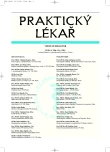Wilson’s disease
Authors:
Z. Mareček
Authors‘ workplace:
Přednosta: Doc. MUDr. M. Zavoral, Ph. D
; Interní klinika 1. LF UK a ÚVN Praha
Published in:
Prakt. Lék. 2007; 87(1): 17-22
Category:
Various Specialization
Overview
Wilson’s disease is an autosomal recessive genetic disease resulting from copper toxicity, primarily in the brain and liver. The disease is caused by mutation in the ATP7B gene, which leads to a disturbance of copper excretion from the organism. Hepatic or neurological symptoms typically occur in the second and third decades of life, although the overall age of presentation can be quite broad (5-60 years). Patients with a liver form of disease may present with an acute hepatitis, chronic hepatitis, fulminant hepatitis or liver cirrhosis. Neurologic manifestations may occur without liver disease and present in a large variety of ways, including movement disorders, often with dysarthria, tremor, and dystonia occurring in any combination. Often patients present with behavioural abnormalities before developing neurological symptoms.
Screening tests include serum ceruloplasmin, and copper assays, 24h urine copper, Kayser-Fleischer ring examination by slit lamp. The definitive diagnostic test is percutaneous liver biopsy with quantitative assay of copper. Mutation analysis is generally not useful because of the large number of causative mutations. It has been well-documented that oral D-penicillamine results in complete reversal or alleviation of hepatic, neurological, and psychiatric abnormalities in most patients with Wilson’s disease, and this drug remains the „gold standard“ therapy for this disorder. Up to 20 % of Wilson’s disease patients develop side effects. As an alternative treatment, zinc is fully effective in Wilson’s disease as long at the patients complies with therapy. Zinc has an excellent safety profile. The only toxicity is gastric irritation in 5–10 % of patients. Tetrathiomolybdate is not yet commercially available in the Czech Republic. An immediate liver transplant is the only treatment possible for patients with acute liver failure.
Key words:
Copper, Wilson’s disease, diagnostics, treatment.
Labels
General practitioner for children and adolescents General practitioner for adultsArticle was published in
General Practitioner

2007 Issue 1
Most read in this issue
- Chronic renal failure in primary care
- Craniopharyngioma in 79 years old man – a case study
- Wilson’s disease
- Hypoglycaemia-associated autonomic failure, its clinical assessment and treatment.
